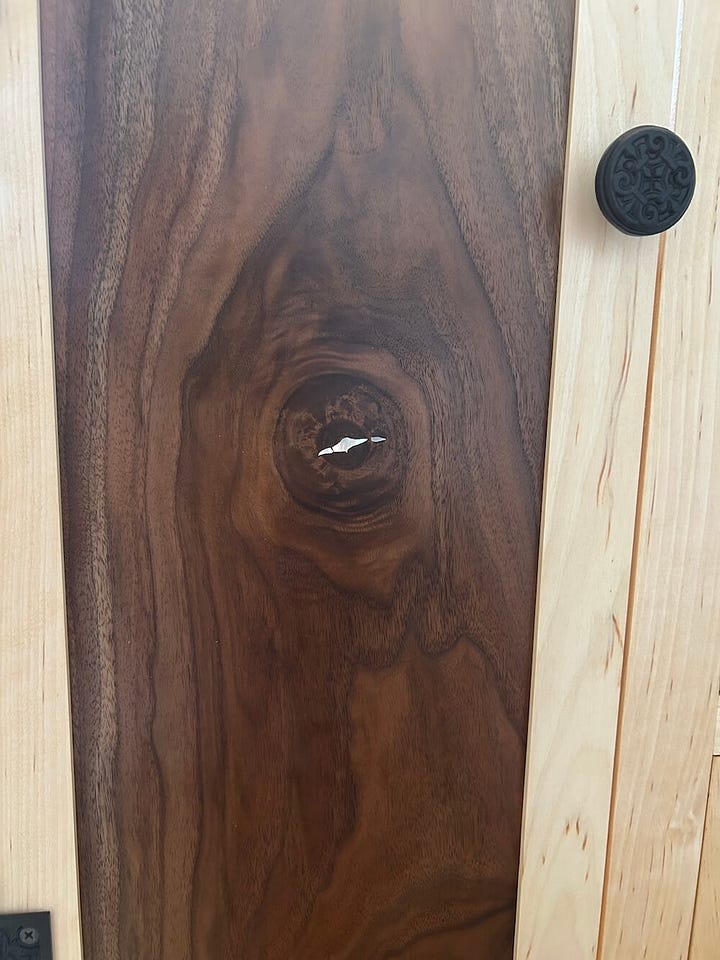Negative capability
Managing the gremlins
Willkommen, bienvenue, welcome.
Josiah, the conference-going fiend and my long-time partner, and I went to see Cabaret at the Guthrie Theater last weekend and it was marvelous. I don’t generally like musicals but this one was brilliant. And the story resonated for our times.




Some photos of my recent work—this is the sink vanity for my friends (the second part of the commission I mentioned last time). There was a crack in the walnut panel I wanted to use for the door and a knot in the board I wanted to use for the drawer fronts. I save slivers and scraps of pearl from other projects, so I went through that pile and reshaped some of them to fill the cracks. When possible, I like to incorporate blemishes in the wood into the work I do. I’m fascinated by imperfections, by the material that we deem less than worthy.
My essay is below, followed by a link to another essay with a similar take that you might enjoy. I hope the next couple of weeks are good to you. ❤️
Negative capability
Every damn day I think of giving up. Of all the areas I fall short.
The noise of it rumbles into a roar when tension is high around a particular aspect of my work—once the big actions are taken (boards planed to thickness, cut to width and length), once it’s time for the details. When every screw up hurts more because of all the time already spent and the additional time it’ll take to fix.
I just finished reading Oliver Burkeman’s The Antidote in tandem with completing work on the drawers of my friends’ vanity. The book is about the negative path toward happiness and in his chapter on death, he quoted extensively from Ernest Becker’s The Denial of Death. I haven’t read that book in more than two decades but will have to revisit it.
A quote that seems particularly relevant today:
‘It is [fear] that makes people so willing to follow brash, strong-looking demagogues with tight jaws and loud voices,’ wrote Becker—leaders ‘who seem most capable of cleansing the world of the vague, the weak, the uncertain, the evil. Ah, to give oneself over to their direction—what calm, what relief.
I’m reticent to admit my own familiarity with fear and uncertainty. The time and energy spent attempting to remove their tendrils from my character. To no end. And there is no demagogue offering a safe harbor that I can cling to (not like there ever is, even as people are seeking just such a figure these days here and abroad, even as we’re paying the price for that folly).
Bringing this back to woodworking: the gremlins of doubt are especially prevalent during the details of a project. They whisper that I’m lazy and incapable. They bring to mind the many valid reasons for self-loathing, that at my core, I’m entirely without worth.
All this in response to making two drawers. You’d think, perhaps, I’m in the wrong line of work. But these thoughts are what I bring to the work, not what the work brings out in me.
My task was to turn six boards into two narrow drawers with dovetail joinery. Cutting the boards carefully gave me enough material for an additional side and a front/back piece, should I screw up while making the dovetails. I proceeded cautiously, double checking my measurements and testing for fit as I went.
Then I set up the dovetail jig. The set up of any intricate cut for joinery often takes longer than the actual work itself. I used several scraps to test my depth of cut for the half blind dovetails I wanted to make.
A quick aside: “half blind” means the dovetails are only visible on the sides of the box, as they only go halfway through the back and front pieces of wood. “Dovetails” are interlocking pins and tails (don’t ask me which is which because I can never remember) cut into the ends of two boards to make a 90-degree joint that is quite sturdy and can hold up to years, decades of use. Some woodworkers cut these by hand. Some are cocky about their ability to do that. I’m neither.


The jig was set up, the boards for the two boxes all properly marked, the joints ready to be cut. My gremlins, devoted critics who hate to miss a day of work, were singing in chorus about how I’d overlooked something and it wouldn’t become apparent until it was too late to fix. That I’d return to the farm, hat-in-hand, and have to tell Dad I was no longer able to cut dovetails by myself and would need more material and his assistance. That if I were any kind of a woodworker, I wouldn’t be having these thoughts and feelings, I’d be done with this task already.
I cut the dovetails for the first corner of the drawer and it went well.
Dust swirling in the air, I get the next two boards, set them up in the jig, and begin to cut again. Within 30 seconds, I can tell something is wrong. The bit in the router feels like it’s working too hard. I turn off the router and look. The cut has gotten deeper as I’ve gone along. I check the bit in the router and it looks like it’s moved. How this has happened, I don’t know. Apparently it wasn’t tight enough in the router collet.
My earlier fear has been realized: these two boards are unsalvageable.
My gremlins love this. This is the juicy material they are made of. For all the care and thoughtfulness I think will confine my mistakes into a box that never gets opened—well, clearly I can’t even make that box very well because once again I’ve messed something up.
Screwing up in the shop, I’ve come to believe, begets twins:
One offspring is a sinking feeling that can morph into anger (I’ve heard of woodworkers who throw items across their shop, which is not one of my tactics—swearing is so much cheaper and causes less damage) or despair.
Another offspring, its twin, is relief. Because the screw up is here and it’s done. The fear you had is now reality and that means it’s just another three dimensional problem that needs solving, which is all woodworking ever is.
The gremlins have their fresh meat and I get back to work. Grab those two extra boards that were backups and put them into service. Tighten the collet in my router and reset the bit depth. Take a breath and cut the next corner. No problems. Move on.
Near the end of his book, Burkeman quotes John Keats, a poet I only recall from college and also haven’t read since. Keats wrote, in a letter to a friend:
“[I]t struck me what quality went to form a Man of Achievement . . . I mean Negative Capability, that is, when a man is capable of being in uncertainties, mysteries, doubts, without any irritable reaching after fact and reason.”
I’m not a Man of Achievement. I’d like to say I aspire to some kind of professional achievement, but herein the gremlins are truthful: I am too lazy. I very much like to have time off to play or write or do non-work related activities.
Perhaps though I have achieved negative capability. Every day I live with uncertainties—from the nibbling to the gnawing—and still show up at the workbench. This is of necessity: switching careers and pursuing my passion for woodworking didn’t change my gremlins. Getting better at the craft hasn’t changed them either. The thought arises that I should give up. I let it go and get on with my work.
Another thought from another writer
Just read this piece and thought I’d share it here: “It follows that one of the best things you can do for your confidence is feel off and still perform well. It frees you from the need to have perfect conditions to give it a go. You provide yourself with the evidence that you are resilient, durable, robust and can get the job done.”





